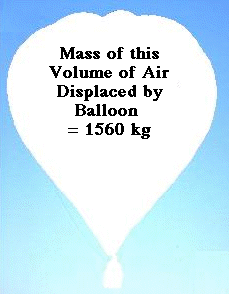Answer:
F = 12,387 Newtons
Steps to complete the problem:
- List all of the variables given.
Mass of balloon = 80 kg
Volume of balloon = 1200 m3
Density of Helium = .18 kg/m3
Density of Air = 1.3 kg/m3
- Determine the the total mass that can be lifted by
the helium balloon.
Mass lifted = mass of the volume of fluid
displaced
Mass = (1200 m3)( 1.3 kg/m3)
Mass = 1560 kg
The total amount that can be lifted = 1560 kg
(including balloon, helium and payload)
|

|
- Determine the mass that is displaced.
- Determine the mass of helium.
(1200 m3)*(.18
kg/m3) = 216 kg
- Subtract the mass of the balloon and mass
of the 1200 m3 volume of helium from the
total mass that can be lifted.
1560 kg - 80 kg - 216 kg = 1264 kg
- Determine the Force required to lift the displace
volume of 1200 m3.
F = mg (where g is gravity)
F = (1264 kg) * (9.8 m/s2)
F = 12,387 Newtons
|

|
Return to Bouyancy
Lesson
|
|
